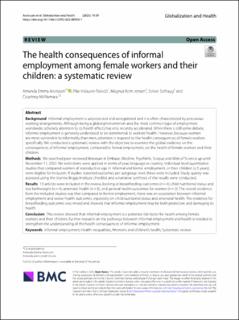| dc.description.abstract | Background
Informal employment is unprotected and unregistered and it is often characterized by precarious working arrangements. Although being a global phenomenon and the most common type of employment worldwide, scholarly attention to its health effects has only recently accelerated. While there is still some debate, informal employment is generally understood to be detrimental to workers’ health. However, because women are more vulnerable to informality than men, attention is required to the health consequences of female workers specifically. We conducted a systematic review with the objective to examine the global evidence on the consequences of informal employment, compared to formal employment, on the health of female workers and their children.
Methods
We searched peer-reviewed literature in Embase, Medline, PsychInfo, Scopus and Web of Science up until November 11, 2022. No restrictions were applied in terms of year, language or country. Individual-level quantitative studies that compared women of reproductive age in informal and formal employment, or their children (≤ 5 years), were eligible for inclusion. If studies reported outcomes per subgroup level, these were included. Study quality was assessed using the Joanna Briggs Institute checklist and a narrative synthesis of the results were conducted.
Results
13 articles were included in the review, looking at breastfeeding outcomes (n = 4), child nutritional status and low birthweight (n = 4), antenatal health (n = 3), and general health outcomes for women (n = 2). The overall evidence from the included studies was that compared to formal employment, there was an association between informal employment and worse health outcomes, especially on child nutritional status and antenatal health. The evidence for breastfeeding outcomes was mixed and showed that informal employment may be both protective and damaging to health.
Conclusion
This review showed that informal employment is a potential risk factor for health among female workers and their children. Further research on the pathways between informal employment and health is needed to strengthen the understanding of the health consequences of informal employment. | en_US |

